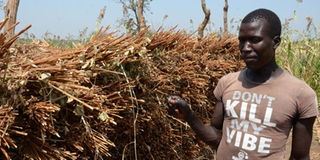With simsim, erratic rains not a problem

Yassin Okwera explains the harvesting and drying process of sesame (simsim). Photo by George Katongole
What you need to know:
- Planting simsim is not labour intensive as the crop is easy to manage and needs little water throughout the year. The plant takes three months to mature. It can be planted either on seedbed before it is transplanted or through broadcasting, writes Christine Katende.
Yasiin Okwera is an oil seeds farmer from Agweng Sub-county in Gulu District. He is 22 years old. He is a young man whose parents that were murdered during the LRA insurgency in the early 2000.
Despite his young age (16 year old then) Okwera buried the hatchets and resumed with life as he had to take care of his siblings. He was in Primary Seven at Pece Primary School in Gulu at that time.
From the camp where Okwera and his two little siblings had gone to seek refuge, he started in farming as a way to sustain the family.
He dealt in crops such as maize for both commercial and subsistence purposes. He later ventured into simsim growing but he did not earn as much since most of it would get wasted as termites invaded them during the drying process thus registering losses.
Okwera joined Gulu Agricultural Development Company limited (GADC) to engage in organic sesame growing and he is one of the certified oil seed farmers selected by this company.
“I have embraced the new technologies that have been extended to us as farmers through the sesame organic growing trainings, and this has increased my yields,” he happily reveals.
Given the uncountable benefits in organic sesame growing like ready market, he embraced the new practices and he does not regret being a registered farmer given how much he has received so far.
Unlike before, Okwera now starts with land opening, plough then plant among other steps as he has been trained by officials of the agricultural company.
Okwera expounds that he buys planting material (sesame seeds) from eligible and certified farmers because there is easy traceability in case of anything as opposed to when he just gets them from the shops.
According to the oil seed famer, simsim is an easy crop to look after so long as a farmer follows all the steps very well.
As a way of managing pests, Okwera intercrops his simsim with sorghum (Obama variety) which traps pests that would have destroyed the crop.
The sorghum, according to Okwera, does not only trap pests but it is also left to grow, mature then used for home consumption.
To get better yields
One should plant a recommended sesame variety for a particular region.
Farmers are advised to plant at the onset of short rains. When plants are about 10cm high, thinning is done to leave five plants a hole. Weeding is done two weeks after germination. Second weeding comes after thinning.
The crop does not require fertiliser since it survives in soils that are not fertile.
To get better yields, the crop requires spraying against pests and diseases.
During harvesting, the crop is uprooted or the stem is cut at its base to prevent capsules from shattering. Then the stems are tied into bundles for drying.
Harvest time
Towards harvest time, Okwera clears part of his land in preparation for proper drying.
He constructs a rack on which he piles the bundled sesame after harvesting.
However, prior to cutting the ready sesame, Okwera makes sure he has clean tauplines on which he puts his harvest.
The bundles of simsim are properly piled on the rack for three weeks before threshing is done.
As a trained sesame farmer, Okwera threshes the simsim on a clean taupline so as to maintain a good hygiene as well as the quality.
The next step is winnowing after which he packs the clean sesame in 100-kilogramme sacks and takes it the market for selling. From the recent harvest which he planted on one and half acres of land, Okwera expects more than Shs1.4m from 350 to 400 kilogrammes of sesame.
“I would have made more money but due to the already registered losses of which resulted from late harvest, the kilograms are going to be less,” he laments.
Challenges
Among the challenges the simsim farmer points out is the changing weather patterns which results into planting out of the planting window, as this results into low yields hence registering losses because this specific crop does not perform well if planted in a wrong season.
Okwera foresees a better life for both him and his siblings in the next five years.
He believes he would have constructed a permanent building by then and increased on the output.
Because he produces quality simsim, he is sure of ready market even if it is not GADC, he says he can supply the Gulu local market as well as traders in Kampala.
Apart from simsim, Okwera also farms other crops like maize, soya beans, and sunflower. He has been actively engaged in farming for the last eight years.
Achievements
Because no work goes without pay, Okwera is happy to reveal that ever since he joined organic sesame growing, he is able to sell his produce without hustling, and given the quality of what he produces he always finds ready market. He make more than Shs4m, a year from sesame.
Although Okwera was unable to complete his primary education, he is at least contented that he has been able to provide for his siblings.




